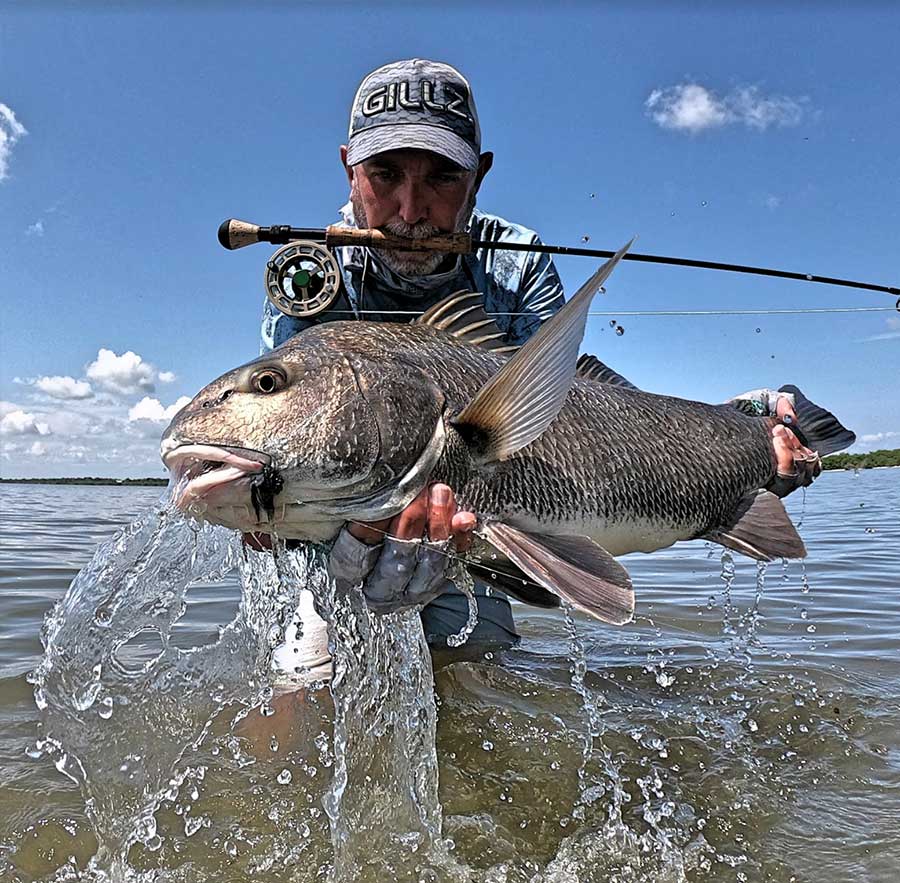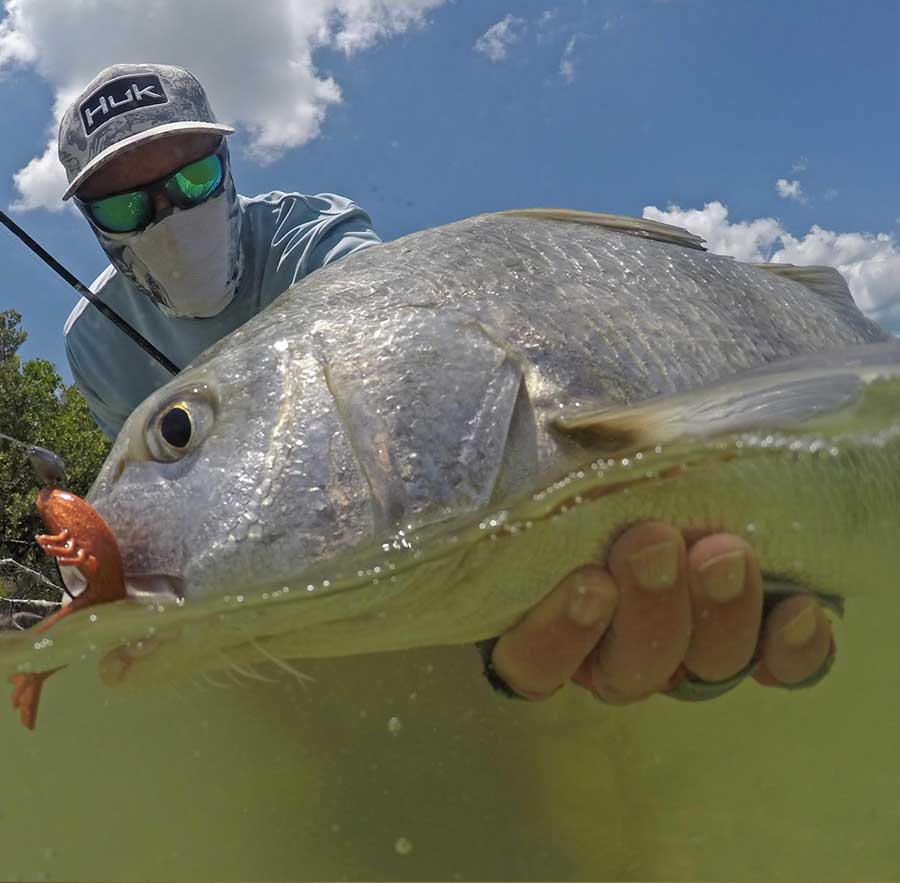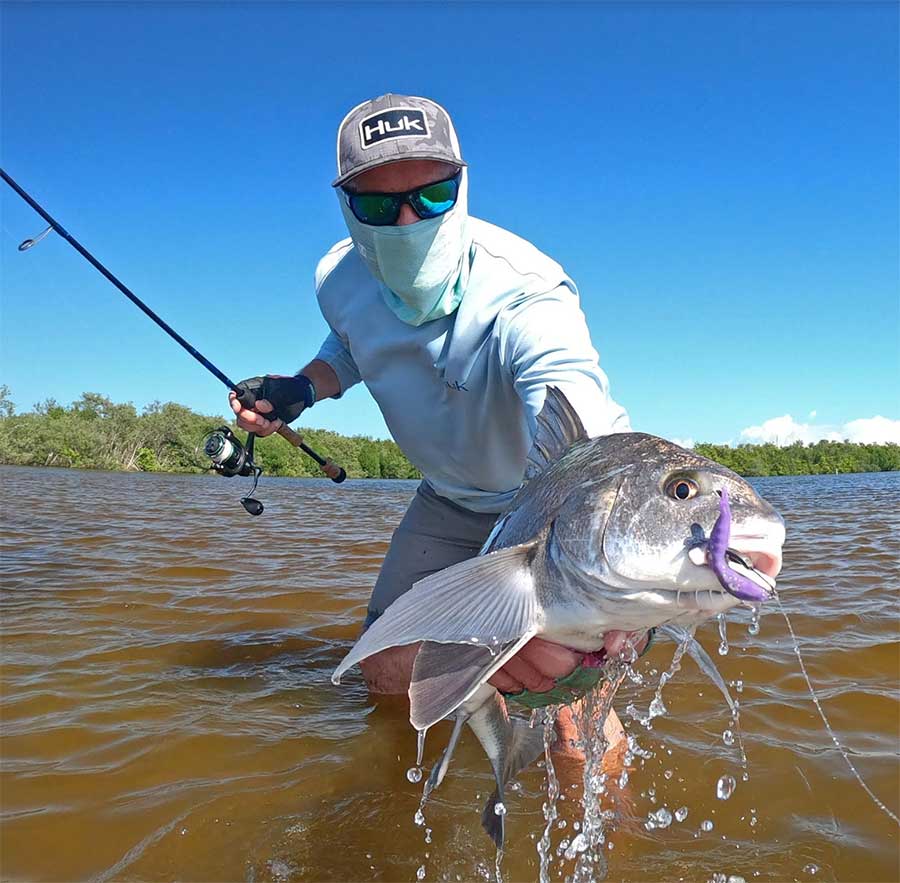If you fish the flats in east central Florida you’ve likely encountered black drum. Little slot sized drum up to big brutes that weigh 25 pounds or more inhabit our shallows year around, although they are a little less prevalent in the summer. Black drum are crustacean eaters. Toss a shrimp, chunk of crab or piece of clam in their path and they are probably going to eat. The real challenge comes when you try to catch them on artificials.
Years ago we would cast gold spoons, DOA Shrimp or whatever we had tied on for redfish at the black drum we saw. We’d catch one now and then but our success rate was dismal. I’d toss natural looking crab and shrimp flies at drum and again success rates were low. All that changed after a conversation with Captain Scott Nichols who was a local guide back in those days.
Nichols told me he had been having good luck catching drum on black flies. I tied up some Merkins, a classic crab imitation, with black yarn bodies and a pair of splayed grizzly hackle feathers to represent claws. I tied them on 1/0 hooks and added lead dumbbell eyes to get them down to the bottom fast. They were tough to cast but worked great, far better than any other lure I had ever tried. They worked so well that I started tying them on jig heads so that my non-fly fishing friends could catch drum too.
For years the black and grizzly Merkins were my go to artificial for black drum. The problem with Merkins is they are not a great multi-species fly, so I usually brought a fly rod with a Merkin that was reserved for nothing but black drum.
My next evolution in drum fishing came with Captain John Kumiski told about a fly he calls the Redfish Worm. It is a very simple tie, much easier than a Merkin. It is simply a rabbit strip tail, cactus chennile wrapped body and dumbbell eyes. I tied up some all black versions about three inches long on #1 hooks. They worked as well as the Merkin on black drum, and as a bonus, they worked great on redfish, trout and just about every other fish in our lagoons.
Over the years I’ve come to the conclusion that black lures, whether conventional or fly, with somewhat of a shrimpy or crabby look to them, will catch black drum. I’ve even had success with black hellgrammite lures from a company called Nikko.
There are three things you need to be aware of if you want to catch black drum on lures; they feed on the bottom, they don’t chase down fast moving prey and the lure needs to be close for them to see it. You absolutely need a lure that sinks, preferably fairly fast so you can get it in front of the drum before it changes directions. In ideal circumstances you will see the drum well enough to tell which end is the head and which end is the tail. Imagine a dinner plate size circle just in front of the drum’s nose. Get your lure inside that circle and there is a fair chance you’ll get a bite, but outside that circle your chances drop dramatically. Once you get the lure on the nose of the drum, give it small twitches. Your goal is to give action to the lure without having it move too far. If you use more aggressive hops like you might for a redfish, you risk the lure moving too far and the drum losing track of it. You goal should be just enough movement to catch the drums attention but nothing more.
Last year I had a surprise revelation in regard to lure colors. Black drum love purple lures, maybe even more than black. I accidentally discovered that when trying out purple shrimp from a new line of lures called Q8 Super Baits. Honestly I probably would’ve never tried a purple shrimp lure if they had not given me a free pack at ICAST. I’m glad they did. Those Q8 purple shrimp have caught me all sorts of black drum plus almost everything else, from redfish to tarpon. Q8 baits are scented, which I’m sure contributes to their success, but I catch more drum on purple than any other color they offer. I like to fish the Q8 Shrimp on a 3/0 weighted swimbait hook (1/16 or 1/8 ounce) with a spring bait keeper (like the Gamakatsu 296413-1/8 or 296413-1/16). Purple is now a regular part of my saltwater arsenal, which is something I would’ve never thought a couple years ago.
Catching black drum on the flats with lures is a great challenge that will test of one’s skills at sighting fish and making accurate casts and presentations. But black drum can be finicky fish. There are no guarantees in fishing, and that is especially true of drum on artificials. You can make the perfect presentation with the right lure and not get bit. Still, if you are on with your casting and presentation game, and you use the right lures, then black drum will bite on artificial baits often enough to make it well worth the effort.






Leave A Comment
You must be logged in to post a comment.